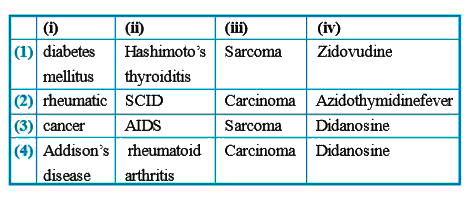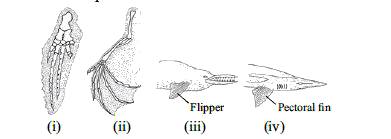Select the correct option that correctly fill the blanks i-iv.
I . Less than (i)____ of genome represents structural genes that code for proteins.
ii. Chemical substance that binds with repressor and convert it into a non-DNA binding state is (ii)_____.
III. In prokaryotes, during replication RNA primer is removed by (iii) where as in eukaryotes it is removed by(Iv)______.
(i)(ii)(iii)(iv)5%regulator DNA polymerase II DNA polymeraseβ
(i)(ii)(iii)(iv)10%regulator DNA polymerase I DNA polymeraseα
(i)(ii)(iii)(iv)2%inducer DNA polymerase I DNA polymeraseβ
(i)(ii)(iii)(iv)50%inducer DNA polymerase III DNA polymeraseα
The correct Answer is:C
Step by step video, text & image solution for Select the correct option that correctly fill the blanks i-iv. I . Less than (i)____ of genome represents structural genes that code for proteins. ii. Chemical substance that binds with repressor and convert it into a non-DNA binding state is (ii)_____. III. In prokaryotes, during replication RNA primer is removed by (iii) where as in eukaryotes it is removed by(Iv)______. by Biology experts to help you in doubts & scoring excellent marks in Class 12 exams.
Topper's Solved these Questions
Similar Questions
Select the option correctly identifies I, II,III and IV.
 View Solution
View SolutionRefer to the given statements and select the option that correctly fill the blanks.
I. In __(i) __ and __(ii)__ , the immune system starts destroying body's own proteins.
II. __(iii)__ is the maligent growth of tissues derived from primitive mesoderm.
(III) __(iv)__ was the first drug used for the treatment of AIDS.
 View Solution
View Solution
Knowledge Check
- Question 1 - Select One
Select the correct option representing the excretory organs present in (i) earthworm, (ii) centipede, (iii) prawn, and (iv) flatworm.
A(i)(ii)(iii)(iv)Malpighian tubulesFlame cellNephridiaGreen glandsB(i)(ii)(iii)(iv)Flame cellGreen glandMalpighian tubulesNephridiaC(i)(ii)(iii)(iv)NephridiaMalpighian tubulesGreen glandFlame cellD(i)(ii)(iii)(iv)Green glandNephridiaFlame cellMalpighian - Question 2 - Select One
Mark the incorrect differences between eukaryotic and prokaryotic transcription.
I. In eukaryotes , the genes are split having exons and introns while in prokaryotes it isn't .
ii The structural gene which is to be transcribed is generally mono- cistronic in prokaryotes and poly-cistronic in eukaryotes .
III . The RAN formed with the help of RNA polymerase in eukaryotes requires future processing to function as m-RNA while in prokaryotes it is directly used as m - RNA.
IV. In eukaryotes, RNA polymerase binds to the promoter region while in prokaryotes it binds to the operator region .AI and IVBII and IIICII and IVDIII and IV - Question 3 - Select One
Arrange the various proteins involved DNA replication in the correct sequence they are used.
(i) single strand binding proteins
(ii) Topoisomerase
(iii) Phosphorylase
(iv) DNA ligase
(v) HelicaseA(iii)→(v)→(i)→(ii)→(iv)B(i)→(ii)→(v)→(iii)→(iv)C(v)→(i)→(iv)→(ii)→(iii)D(v)→(ii)→(i)→(iii)→(iv)
Given figures (i), (ii), (iii) and (iv) represent certain parts/structures of animals. Identify the pairs of structures that are analogous to each other and select the correct option.
 View Solution
View SolutionChromatin is constituted with
I. DNA
II. Histones
III. Non-histone proteins
IV. RNAView SolutionRead the following and select the correct option :
A. Carnivora is a/an (i) that involves (ii) and Canidae.
B. Petunia and (iii). belongs to Family (iv)View SolutionSelect the statements that describe characteristics of genes :
(i) genes are specific sequence of bases in a DNA molecule
(ii) a gene does not code for proteins
(iii) in individuals of a given species, a specific gene is located on a particular chromosome
(iv) each chromosome has only one geneView SolutionSelect the statements that describe characteristics of genes
(i) genes are specific sequence of bases in a DNA molecule
(ii) a gene does not code for proteins
(iii) in individuals of a given species, a specific gene is located on a particular chromosome
(iv) each chromosome has only one geneView Solution

